Marketing Report: Comparative Analysis of Starbucks and Nintendo
VerifiedAdded on 2020/07/23
|9
|2676
|112
Report
AI Summary
This report provides an introduction to marketing, focusing on the strategies employed by Starbucks and Nintendo. It covers various marketing techniques such as branding, brand extension, and relationship marketing, as used by Starbucks, and growth strategies like market penetration, market development, product development, and diversification, as used by Nintendo, referencing Ansoff's matrix. The report also addresses legal requirements in marketing, including the Sales of Goods Act, Consumer Protection from Unfair Trading 2008, and the Data Protection Act. Furthermore, it explores market research techniques, including primary and secondary research, qualitative and quantitative research, and their application. The report also delves into market segmentation, discussing geographic, demographic, psychographic, and socio-cultural segmentation. Finally, it examines the marketing mix elements (product, price, place, and promotion) as applied by Starbucks.
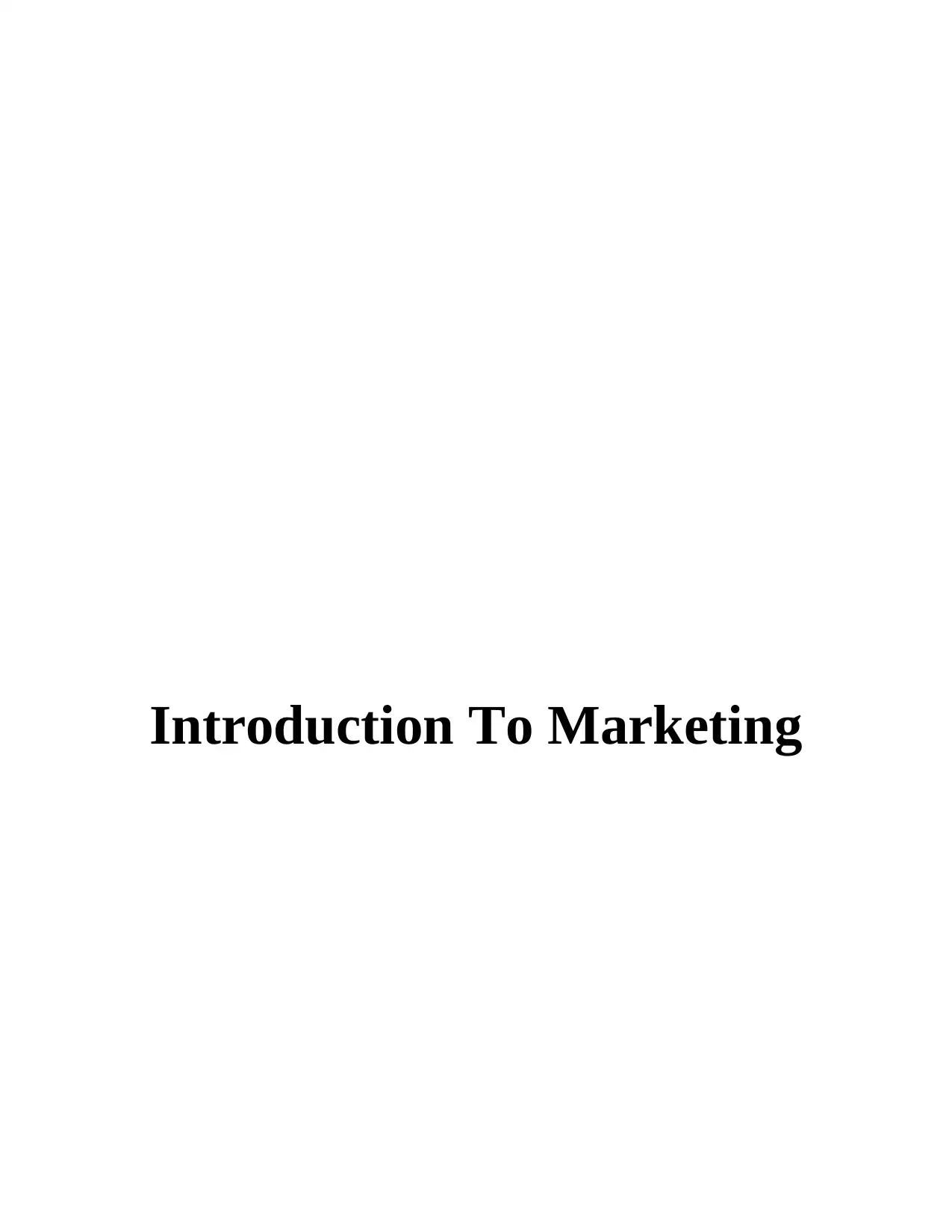
Introduction To Marketing
Paraphrase This Document
Need a fresh take? Get an instant paraphrase of this document with our AI Paraphraser
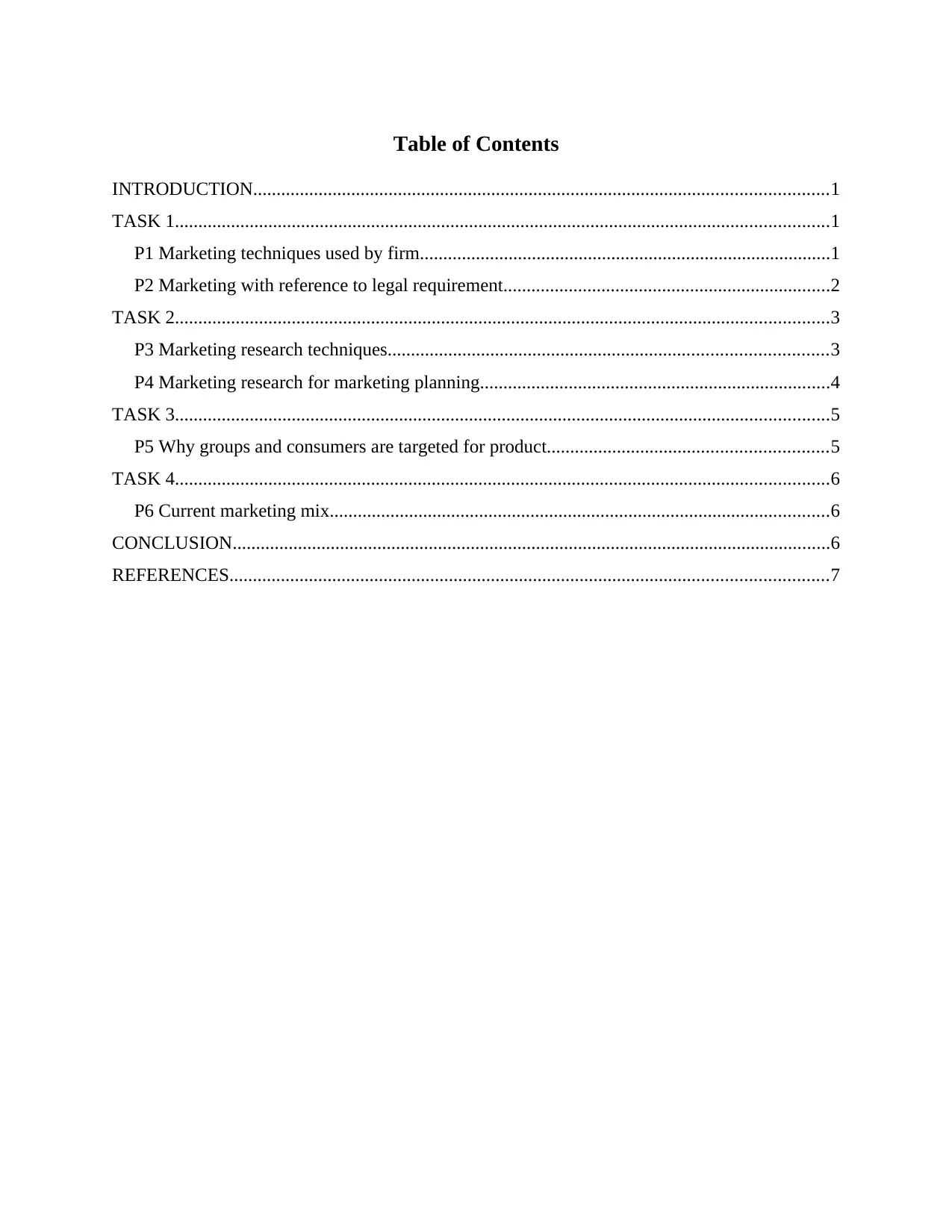
Table of Contents
INTRODUCTION...........................................................................................................................1
TASK 1............................................................................................................................................1
P1 Marketing techniques used by firm........................................................................................1
P2 Marketing with reference to legal requirement......................................................................2
TASK 2............................................................................................................................................3
P3 Marketing research techniques..............................................................................................3
P4 Marketing research for marketing planning...........................................................................4
TASK 3............................................................................................................................................5
P5 Why groups and consumers are targeted for product............................................................5
TASK 4............................................................................................................................................6
P6 Current marketing mix...........................................................................................................6
CONCLUSION................................................................................................................................6
REFERENCES................................................................................................................................7
INTRODUCTION...........................................................................................................................1
TASK 1............................................................................................................................................1
P1 Marketing techniques used by firm........................................................................................1
P2 Marketing with reference to legal requirement......................................................................2
TASK 2............................................................................................................................................3
P3 Marketing research techniques..............................................................................................3
P4 Marketing research for marketing planning...........................................................................4
TASK 3............................................................................................................................................5
P5 Why groups and consumers are targeted for product............................................................5
TASK 4............................................................................................................................................6
P6 Current marketing mix...........................................................................................................6
CONCLUSION................................................................................................................................6
REFERENCES................................................................................................................................7
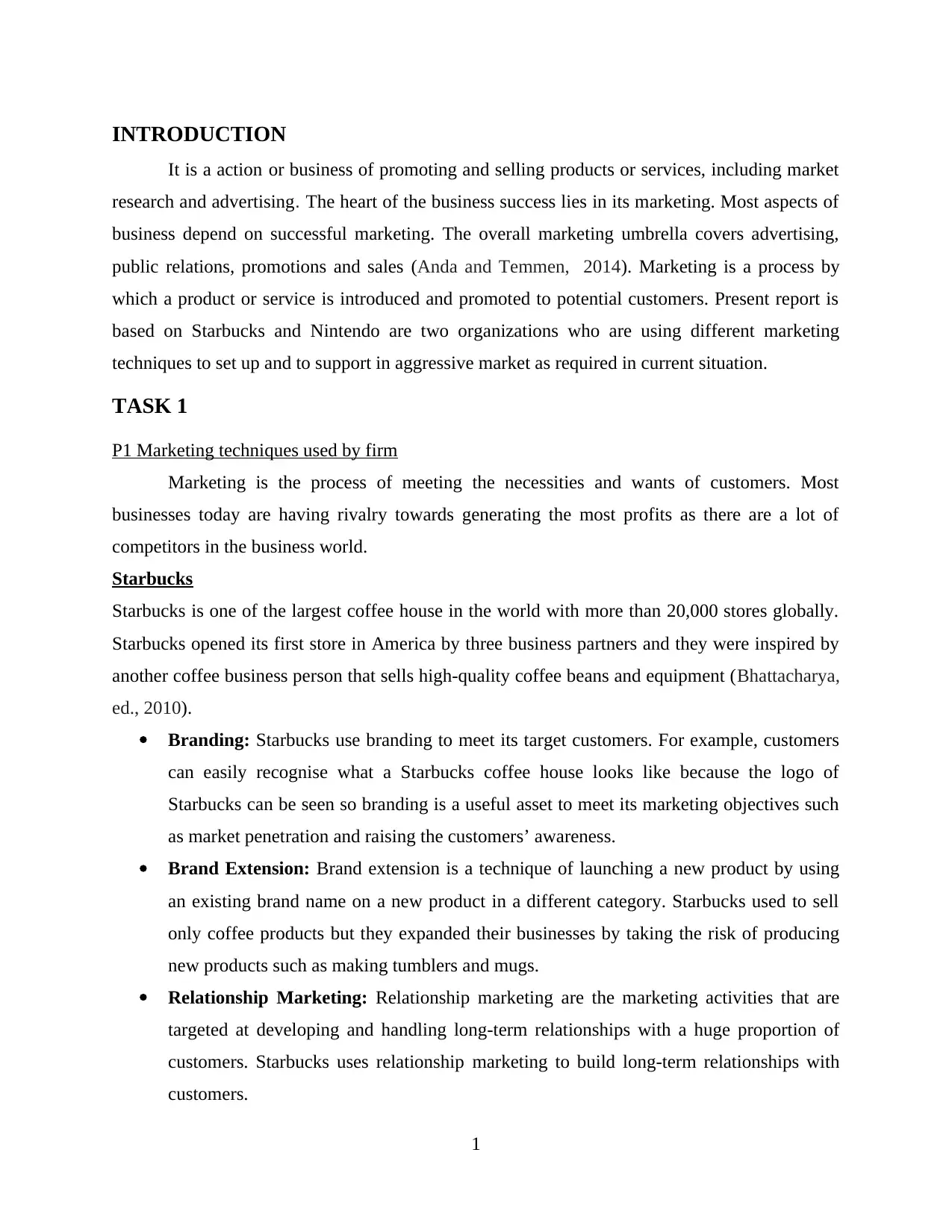
INTRODUCTION
It is a action or business of promoting and selling products or services, including market
research and advertising. The heart of the business success lies in its marketing. Most aspects of
business depend on successful marketing. The overall marketing umbrella covers advertising,
public relations, promotions and sales (Anda and Temmen, 2014). Marketing is a process by
which a product or service is introduced and promoted to potential customers. Present report is
based on Starbucks and Nintendo are two organizations who are using different marketing
techniques to set up and to support in aggressive market as required in current situation.
TASK 1
P1 Marketing techniques used by firm
Marketing is the process of meeting the necessities and wants of customers. Most
businesses today are having rivalry towards generating the most profits as there are a lot of
competitors in the business world.
Starbucks
Starbucks is one of the largest coffee house in the world with more than 20,000 stores globally.
Starbucks opened its first store in America by three business partners and they were inspired by
another coffee business person that sells high-quality coffee beans and equipment (Bhattacharya,
ed., 2010).
Branding: Starbucks use branding to meet its target customers. For example, customers
can easily recognise what a Starbucks coffee house looks like because the logo of
Starbucks can be seen so branding is a useful asset to meet its marketing objectives such
as market penetration and raising the customers’ awareness.
Brand Extension: Brand extension is a technique of launching a new product by using
an existing brand name on a new product in a different category. Starbucks used to sell
only coffee products but they expanded their businesses by taking the risk of producing
new products such as making tumblers and mugs.
Relationship Marketing: Relationship marketing are the marketing activities that are
targeted at developing and handling long-term relationships with a huge proportion of
customers. Starbucks uses relationship marketing to build long-term relationships with
customers.
1
It is a action or business of promoting and selling products or services, including market
research and advertising. The heart of the business success lies in its marketing. Most aspects of
business depend on successful marketing. The overall marketing umbrella covers advertising,
public relations, promotions and sales (Anda and Temmen, 2014). Marketing is a process by
which a product or service is introduced and promoted to potential customers. Present report is
based on Starbucks and Nintendo are two organizations who are using different marketing
techniques to set up and to support in aggressive market as required in current situation.
TASK 1
P1 Marketing techniques used by firm
Marketing is the process of meeting the necessities and wants of customers. Most
businesses today are having rivalry towards generating the most profits as there are a lot of
competitors in the business world.
Starbucks
Starbucks is one of the largest coffee house in the world with more than 20,000 stores globally.
Starbucks opened its first store in America by three business partners and they were inspired by
another coffee business person that sells high-quality coffee beans and equipment (Bhattacharya,
ed., 2010).
Branding: Starbucks use branding to meet its target customers. For example, customers
can easily recognise what a Starbucks coffee house looks like because the logo of
Starbucks can be seen so branding is a useful asset to meet its marketing objectives such
as market penetration and raising the customers’ awareness.
Brand Extension: Brand extension is a technique of launching a new product by using
an existing brand name on a new product in a different category. Starbucks used to sell
only coffee products but they expanded their businesses by taking the risk of producing
new products such as making tumblers and mugs.
Relationship Marketing: Relationship marketing are the marketing activities that are
targeted at developing and handling long-term relationships with a huge proportion of
customers. Starbucks uses relationship marketing to build long-term relationships with
customers.
1
⊘ This is a preview!⊘
Do you want full access?
Subscribe today to unlock all pages.

Trusted by 1+ million students worldwide
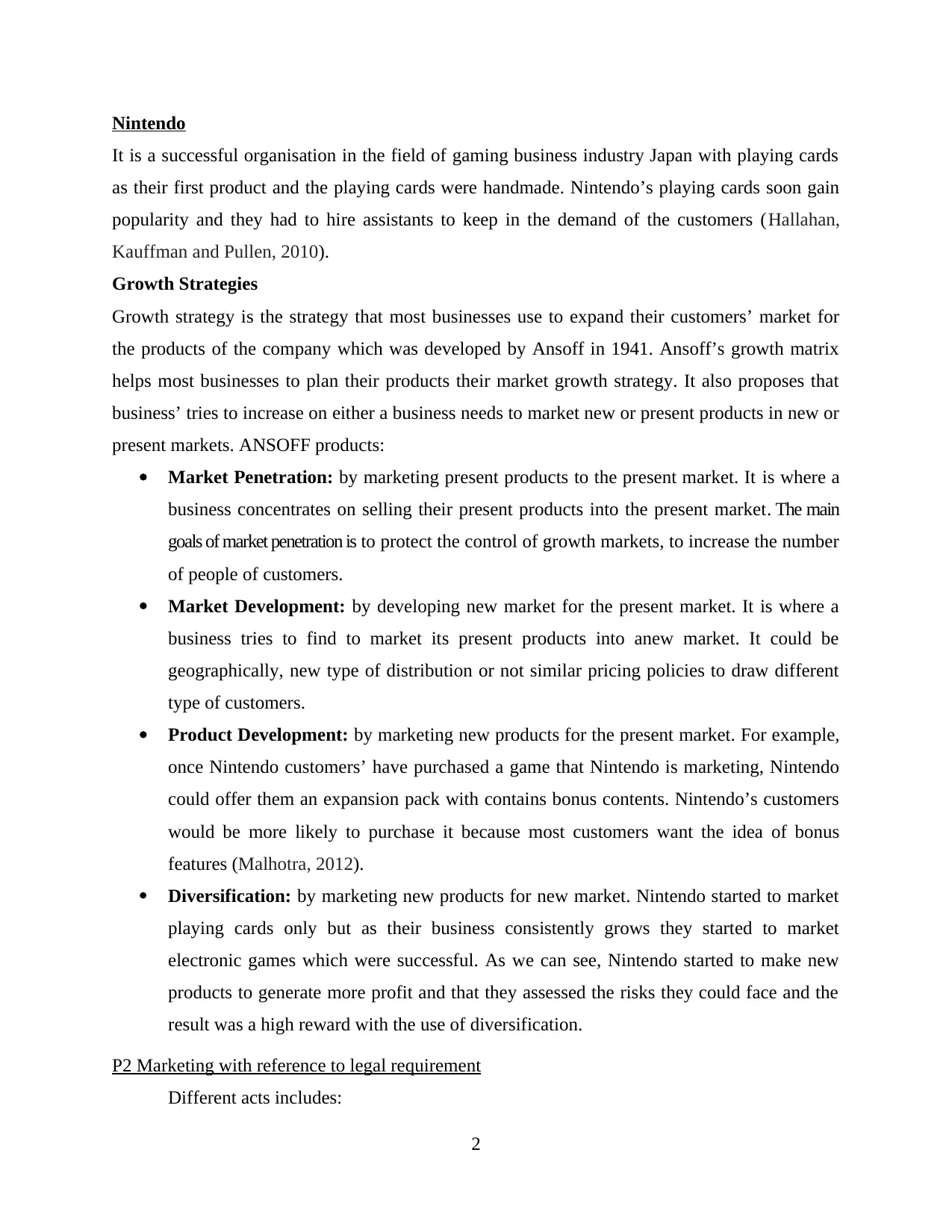
Nintendo
It is a successful organisation in the field of gaming business industry Japan with playing cards
as their first product and the playing cards were handmade. Nintendo’s playing cards soon gain
popularity and they had to hire assistants to keep in the demand of the customers (Hallahan,
Kauffman and Pullen, 2010).
Growth Strategies
Growth strategy is the strategy that most businesses use to expand their customers’ market for
the products of the company which was developed by Ansoff in 1941. Ansoff’s growth matrix
helps most businesses to plan their products their market growth strategy. It also proposes that
business’ tries to increase on either a business needs to market new or present products in new or
present markets. ANSOFF products:
Market Penetration: by marketing present products to the present market. It is where a
business concentrates on selling their present products into the present market. The main
goals of market penetration is to protect the control of growth markets, to increase the number
of people of customers.
Market Development: by developing new market for the present market. It is where a
business tries to find to market its present products into anew market. It could be
geographically, new type of distribution or not similar pricing policies to draw different
type of customers.
Product Development: by marketing new products for the present market. For example,
once Nintendo customers’ have purchased a game that Nintendo is marketing, Nintendo
could offer them an expansion pack with contains bonus contents. Nintendo’s customers
would be more likely to purchase it because most customers want the idea of bonus
features (Malhotra, 2012).
Diversification: by marketing new products for new market. Nintendo started to market
playing cards only but as their business consistently grows they started to market
electronic games which were successful. As we can see, Nintendo started to make new
products to generate more profit and that they assessed the risks they could face and the
result was a high reward with the use of diversification.
P2 Marketing with reference to legal requirement
Different acts includes:
2
It is a successful organisation in the field of gaming business industry Japan with playing cards
as their first product and the playing cards were handmade. Nintendo’s playing cards soon gain
popularity and they had to hire assistants to keep in the demand of the customers (Hallahan,
Kauffman and Pullen, 2010).
Growth Strategies
Growth strategy is the strategy that most businesses use to expand their customers’ market for
the products of the company which was developed by Ansoff in 1941. Ansoff’s growth matrix
helps most businesses to plan their products their market growth strategy. It also proposes that
business’ tries to increase on either a business needs to market new or present products in new or
present markets. ANSOFF products:
Market Penetration: by marketing present products to the present market. It is where a
business concentrates on selling their present products into the present market. The main
goals of market penetration is to protect the control of growth markets, to increase the number
of people of customers.
Market Development: by developing new market for the present market. It is where a
business tries to find to market its present products into anew market. It could be
geographically, new type of distribution or not similar pricing policies to draw different
type of customers.
Product Development: by marketing new products for the present market. For example,
once Nintendo customers’ have purchased a game that Nintendo is marketing, Nintendo
could offer them an expansion pack with contains bonus contents. Nintendo’s customers
would be more likely to purchase it because most customers want the idea of bonus
features (Malhotra, 2012).
Diversification: by marketing new products for new market. Nintendo started to market
playing cards only but as their business consistently grows they started to market
electronic games which were successful. As we can see, Nintendo started to make new
products to generate more profit and that they assessed the risks they could face and the
result was a high reward with the use of diversification.
P2 Marketing with reference to legal requirement
Different acts includes:
2
Paraphrase This Document
Need a fresh take? Get an instant paraphrase of this document with our AI Paraphraser
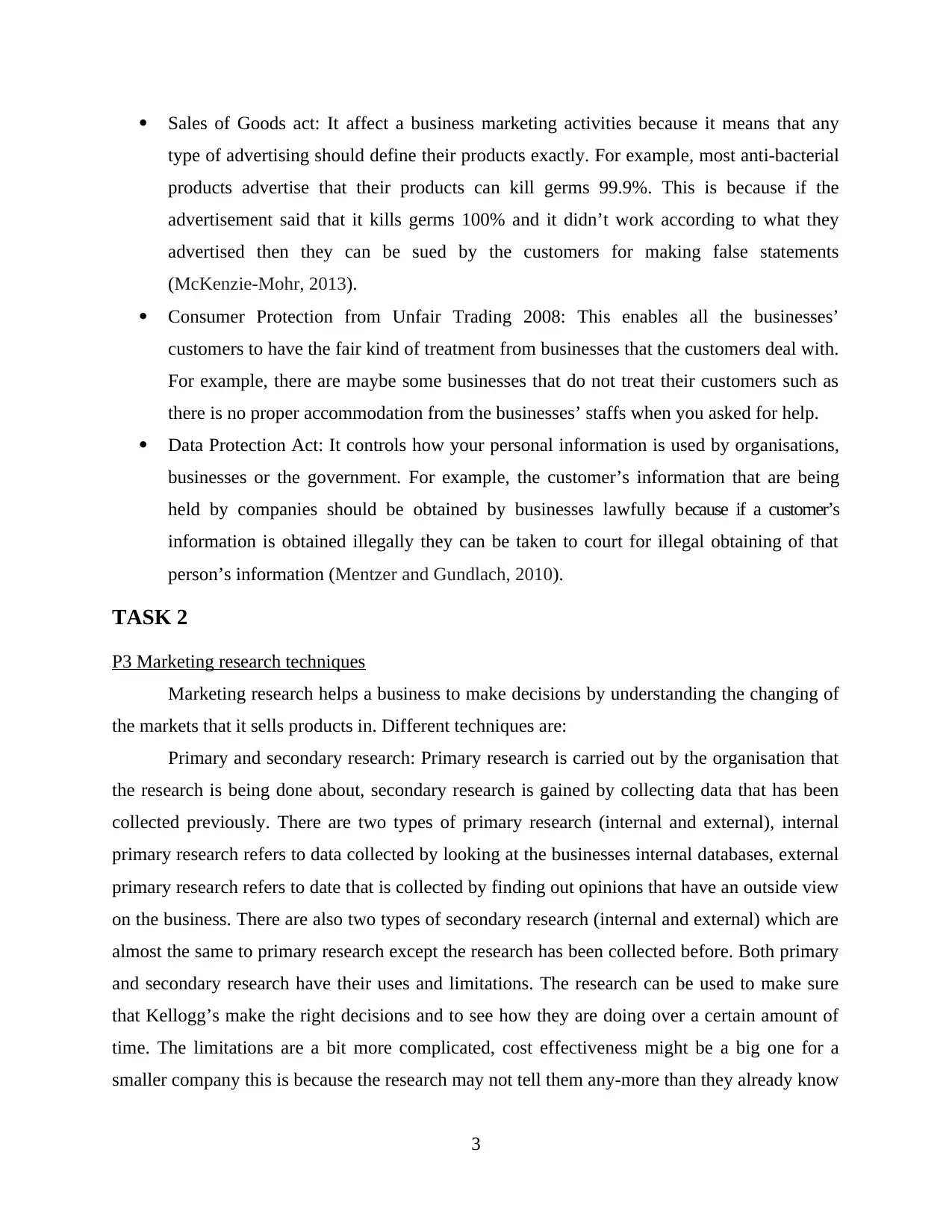
Sales of Goods act: It affect a business marketing activities because it means that any
type of advertising should define their products exactly. For example, most anti-bacterial
products advertise that their products can kill germs 99.9%. This is because if the
advertisement said that it kills germs 100% and it didn’t work according to what they
advertised then they can be sued by the customers for making false statements
(McKenzie-Mohr, 2013).
Consumer Protection from Unfair Trading 2008: This enables all the businesses’
customers to have the fair kind of treatment from businesses that the customers deal with.
For example, there are maybe some businesses that do not treat their customers such as
there is no proper accommodation from the businesses’ staffs when you asked for help.
Data Protection Act: It controls how your personal information is used by organisations,
businesses or the government. For example, the customer’s information that are being
held by companies should be obtained by businesses lawfully because if a customer’s
information is obtained illegally they can be taken to court for illegal obtaining of that
person’s information (Mentzer and Gundlach, 2010).
TASK 2
P3 Marketing research techniques
Marketing research helps a business to make decisions by understanding the changing of
the markets that it sells products in. Different techniques are:
Primary and secondary research: Primary research is carried out by the organisation that
the research is being done about, secondary research is gained by collecting data that has been
collected previously. There are two types of primary research (internal and external), internal
primary research refers to data collected by looking at the businesses internal databases, external
primary research refers to date that is collected by finding out opinions that have an outside view
on the business. There are also two types of secondary research (internal and external) which are
almost the same to primary research except the research has been collected before. Both primary
and secondary research have their uses and limitations. The research can be used to make sure
that Kellogg’s make the right decisions and to see how they are doing over a certain amount of
time. The limitations are a bit more complicated, cost effectiveness might be a big one for a
smaller company this is because the research may not tell them any-more than they already know
3
type of advertising should define their products exactly. For example, most anti-bacterial
products advertise that their products can kill germs 99.9%. This is because if the
advertisement said that it kills germs 100% and it didn’t work according to what they
advertised then they can be sued by the customers for making false statements
(McKenzie-Mohr, 2013).
Consumer Protection from Unfair Trading 2008: This enables all the businesses’
customers to have the fair kind of treatment from businesses that the customers deal with.
For example, there are maybe some businesses that do not treat their customers such as
there is no proper accommodation from the businesses’ staffs when you asked for help.
Data Protection Act: It controls how your personal information is used by organisations,
businesses or the government. For example, the customer’s information that are being
held by companies should be obtained by businesses lawfully because if a customer’s
information is obtained illegally they can be taken to court for illegal obtaining of that
person’s information (Mentzer and Gundlach, 2010).
TASK 2
P3 Marketing research techniques
Marketing research helps a business to make decisions by understanding the changing of
the markets that it sells products in. Different techniques are:
Primary and secondary research: Primary research is carried out by the organisation that
the research is being done about, secondary research is gained by collecting data that has been
collected previously. There are two types of primary research (internal and external), internal
primary research refers to data collected by looking at the businesses internal databases, external
primary research refers to date that is collected by finding out opinions that have an outside view
on the business. There are also two types of secondary research (internal and external) which are
almost the same to primary research except the research has been collected before. Both primary
and secondary research have their uses and limitations. The research can be used to make sure
that Kellogg’s make the right decisions and to see how they are doing over a certain amount of
time. The limitations are a bit more complicated, cost effectiveness might be a big one for a
smaller company this is because the research may not tell them any-more than they already know
3
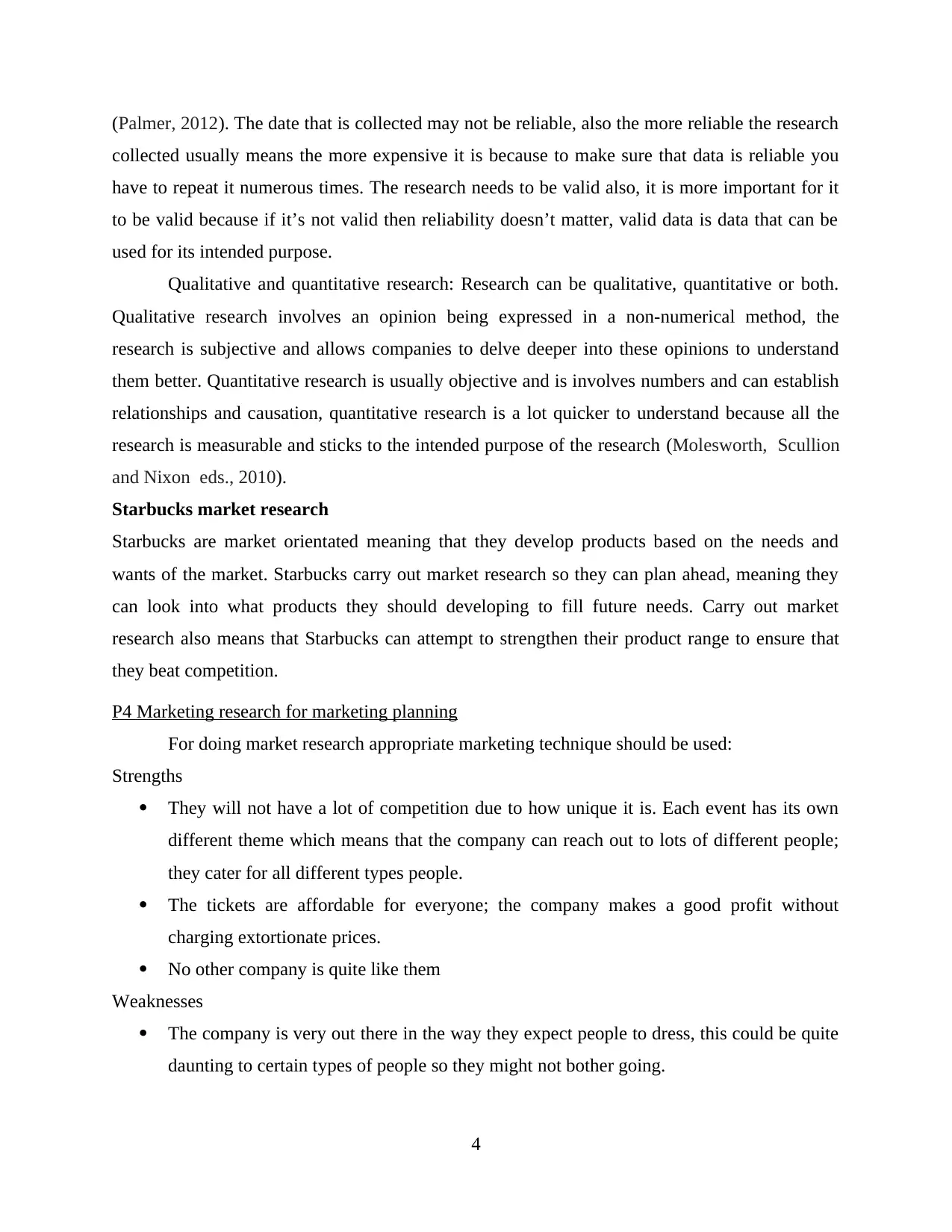
(Palmer, 2012). The date that is collected may not be reliable, also the more reliable the research
collected usually means the more expensive it is because to make sure that data is reliable you
have to repeat it numerous times. The research needs to be valid also, it is more important for it
to be valid because if it’s not valid then reliability doesn’t matter, valid data is data that can be
used for its intended purpose.
Qualitative and quantitative research: Research can be qualitative, quantitative or both.
Qualitative research involves an opinion being expressed in a non-numerical method, the
research is subjective and allows companies to delve deeper into these opinions to understand
them better. Quantitative research is usually objective and is involves numbers and can establish
relationships and causation, quantitative research is a lot quicker to understand because all the
research is measurable and sticks to the intended purpose of the research (Molesworth, Scullion
and Nixon eds., 2010).
Starbucks market research
Starbucks are market orientated meaning that they develop products based on the needs and
wants of the market. Starbucks carry out market research so they can plan ahead, meaning they
can look into what products they should developing to fill future needs. Carry out market
research also means that Starbucks can attempt to strengthen their product range to ensure that
they beat competition.
P4 Marketing research for marketing planning
For doing market research appropriate marketing technique should be used:
Strengths
They will not have a lot of competition due to how unique it is. Each event has its own
different theme which means that the company can reach out to lots of different people;
they cater for all different types people.
The tickets are affordable for everyone; the company makes a good profit without
charging extortionate prices.
No other company is quite like them
Weaknesses
The company is very out there in the way they expect people to dress, this could be quite
daunting to certain types of people so they might not bother going.
4
collected usually means the more expensive it is because to make sure that data is reliable you
have to repeat it numerous times. The research needs to be valid also, it is more important for it
to be valid because if it’s not valid then reliability doesn’t matter, valid data is data that can be
used for its intended purpose.
Qualitative and quantitative research: Research can be qualitative, quantitative or both.
Qualitative research involves an opinion being expressed in a non-numerical method, the
research is subjective and allows companies to delve deeper into these opinions to understand
them better. Quantitative research is usually objective and is involves numbers and can establish
relationships and causation, quantitative research is a lot quicker to understand because all the
research is measurable and sticks to the intended purpose of the research (Molesworth, Scullion
and Nixon eds., 2010).
Starbucks market research
Starbucks are market orientated meaning that they develop products based on the needs and
wants of the market. Starbucks carry out market research so they can plan ahead, meaning they
can look into what products they should developing to fill future needs. Carry out market
research also means that Starbucks can attempt to strengthen their product range to ensure that
they beat competition.
P4 Marketing research for marketing planning
For doing market research appropriate marketing technique should be used:
Strengths
They will not have a lot of competition due to how unique it is. Each event has its own
different theme which means that the company can reach out to lots of different people;
they cater for all different types people.
The tickets are affordable for everyone; the company makes a good profit without
charging extortionate prices.
No other company is quite like them
Weaknesses
The company is very out there in the way they expect people to dress, this could be quite
daunting to certain types of people so they might not bother going.
4
⊘ This is a preview!⊘
Do you want full access?
Subscribe today to unlock all pages.

Trusted by 1+ million students worldwide
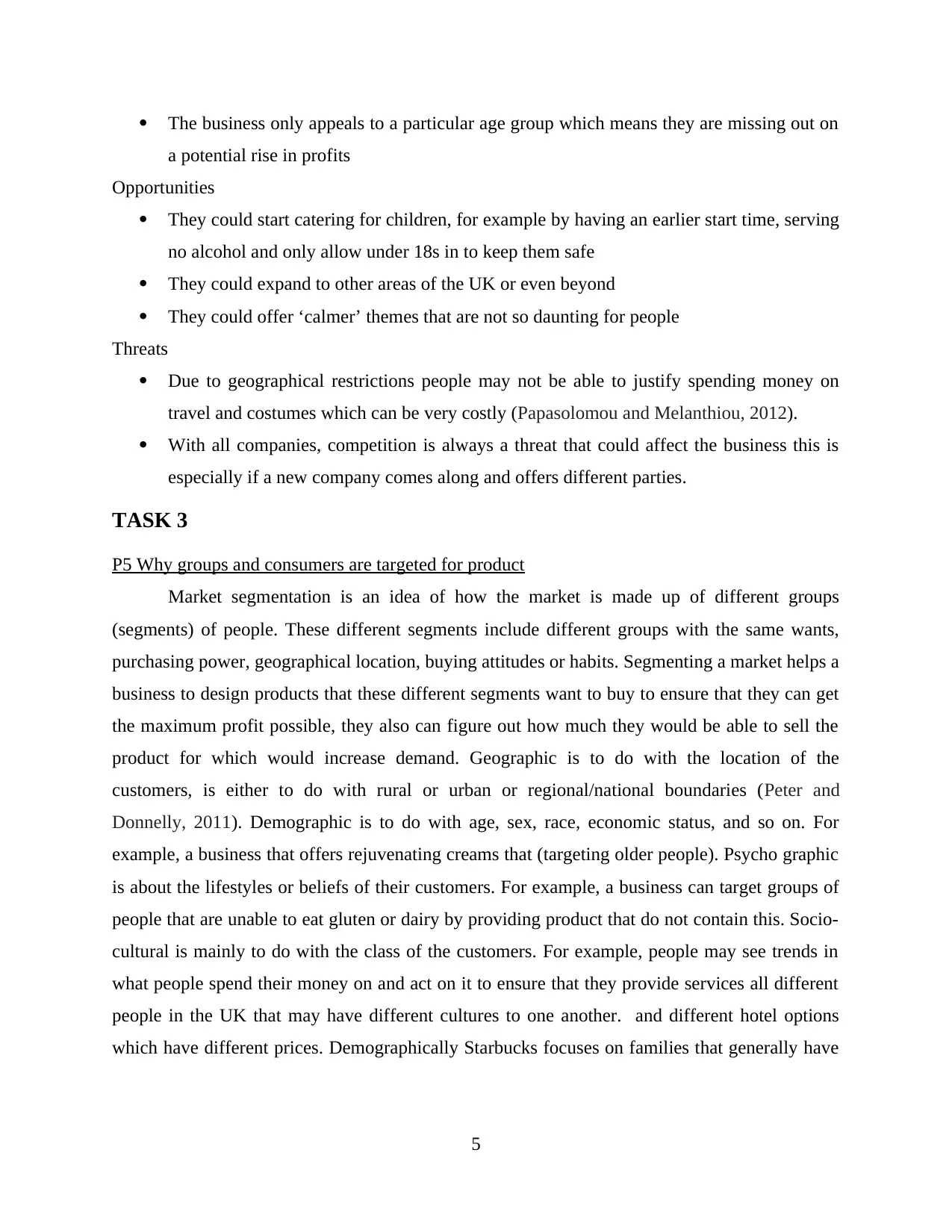
The business only appeals to a particular age group which means they are missing out on
a potential rise in profits
Opportunities
They could start catering for children, for example by having an earlier start time, serving
no alcohol and only allow under 18s in to keep them safe
They could expand to other areas of the UK or even beyond
They could offer ‘calmer’ themes that are not so daunting for people
Threats
Due to geographical restrictions people may not be able to justify spending money on
travel and costumes which can be very costly (Papasolomou and Melanthiou, 2012).
With all companies, competition is always a threat that could affect the business this is
especially if a new company comes along and offers different parties.
TASK 3
P5 Why groups and consumers are targeted for product
Market segmentation is an idea of how the market is made up of different groups
(segments) of people. These different segments include different groups with the same wants,
purchasing power, geographical location, buying attitudes or habits. Segmenting a market helps a
business to design products that these different segments want to buy to ensure that they can get
the maximum profit possible, they also can figure out how much they would be able to sell the
product for which would increase demand. Geographic is to do with the location of the
customers, is either to do with rural or urban or regional/national boundaries (Peter and
Donnelly, 2011). Demographic is to do with age, sex, race, economic status, and so on. For
example, a business that offers rejuvenating creams that (targeting older people). Psycho graphic
is about the lifestyles or beliefs of their customers. For example, a business can target groups of
people that are unable to eat gluten or dairy by providing product that do not contain this. Socio-
cultural is mainly to do with the class of the customers. For example, people may see trends in
what people spend their money on and act on it to ensure that they provide services all different
people in the UK that may have different cultures to one another. and different hotel options
which have different prices. Demographically Starbucks focuses on families that generally have
5
a potential rise in profits
Opportunities
They could start catering for children, for example by having an earlier start time, serving
no alcohol and only allow under 18s in to keep them safe
They could expand to other areas of the UK or even beyond
They could offer ‘calmer’ themes that are not so daunting for people
Threats
Due to geographical restrictions people may not be able to justify spending money on
travel and costumes which can be very costly (Papasolomou and Melanthiou, 2012).
With all companies, competition is always a threat that could affect the business this is
especially if a new company comes along and offers different parties.
TASK 3
P5 Why groups and consumers are targeted for product
Market segmentation is an idea of how the market is made up of different groups
(segments) of people. These different segments include different groups with the same wants,
purchasing power, geographical location, buying attitudes or habits. Segmenting a market helps a
business to design products that these different segments want to buy to ensure that they can get
the maximum profit possible, they also can figure out how much they would be able to sell the
product for which would increase demand. Geographic is to do with the location of the
customers, is either to do with rural or urban or regional/national boundaries (Peter and
Donnelly, 2011). Demographic is to do with age, sex, race, economic status, and so on. For
example, a business that offers rejuvenating creams that (targeting older people). Psycho graphic
is about the lifestyles or beliefs of their customers. For example, a business can target groups of
people that are unable to eat gluten or dairy by providing product that do not contain this. Socio-
cultural is mainly to do with the class of the customers. For example, people may see trends in
what people spend their money on and act on it to ensure that they provide services all different
people in the UK that may have different cultures to one another. and different hotel options
which have different prices. Demographically Starbucks focuses on families that generally have
5
Paraphrase This Document
Need a fresh take? Get an instant paraphrase of this document with our AI Paraphraser
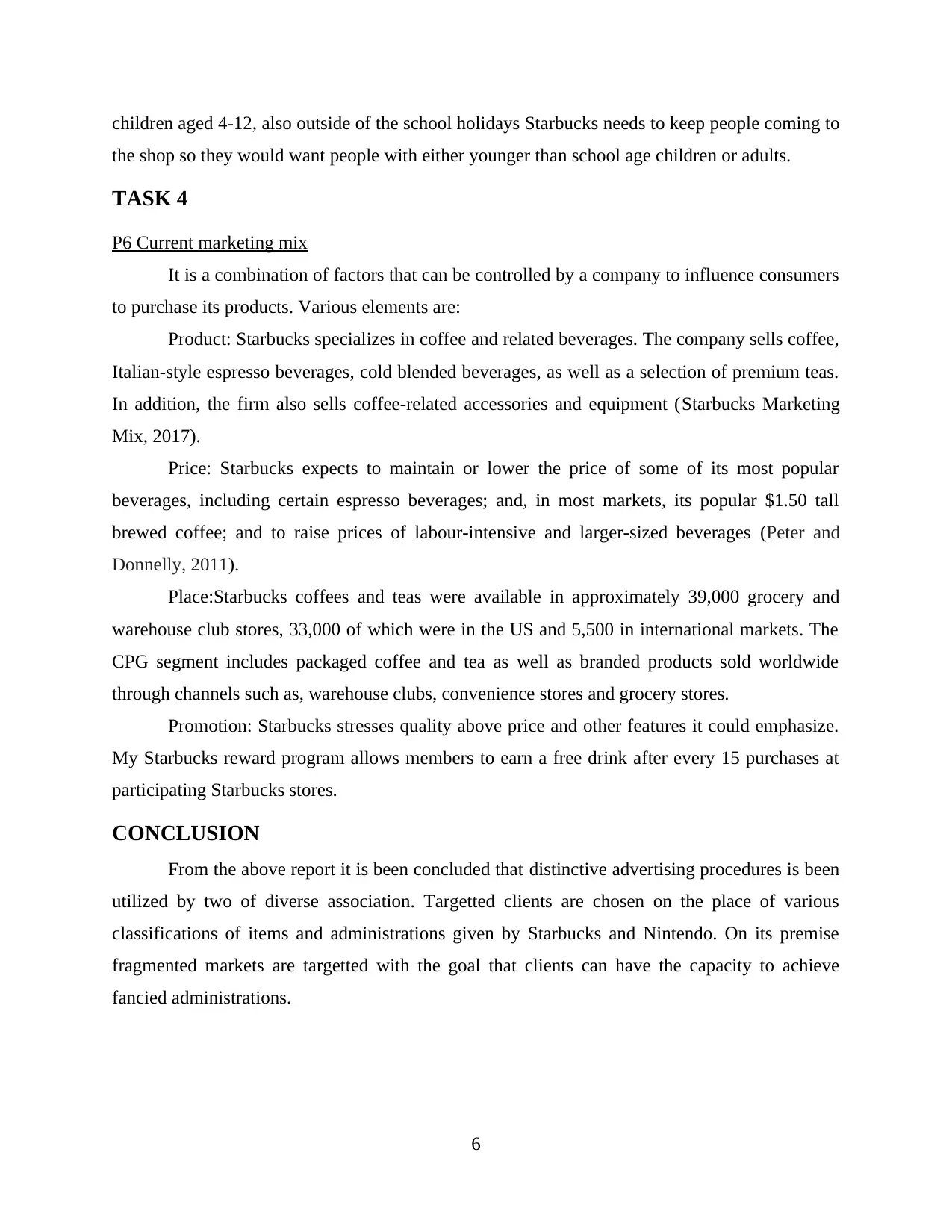
children aged 4-12, also outside of the school holidays Starbucks needs to keep people coming to
the shop so they would want people with either younger than school age children or adults.
TASK 4
P6 Current marketing mix
It is a combination of factors that can be controlled by a company to influence consumers
to purchase its products. Various elements are:
Product: Starbucks specializes in coffee and related beverages. The company sells coffee,
Italian-style espresso beverages, cold blended beverages, as well as a selection of premium teas.
In addition, the firm also sells coffee-related accessories and equipment (Starbucks Marketing
Mix, 2017).
Price: Starbucks expects to maintain or lower the price of some of its most popular
beverages, including certain espresso beverages; and, in most markets, its popular $1.50 tall
brewed coffee; and to raise prices of labour-intensive and larger-sized beverages (Peter and
Donnelly, 2011).
Place:Starbucks coffees and teas were available in approximately 39,000 grocery and
warehouse club stores, 33,000 of which were in the US and 5,500 in international markets. The
CPG segment includes packaged coffee and tea as well as branded products sold worldwide
through channels such as, warehouse clubs, convenience stores and grocery stores.
Promotion: Starbucks stresses quality above price and other features it could emphasize.
My Starbucks reward program allows members to earn a free drink after every 15 purchases at
participating Starbucks stores.
CONCLUSION
From the above report it is been concluded that distinctive advertising procedures is been
utilized by two of diverse association. Targetted clients are chosen on the place of various
classifications of items and administrations given by Starbucks and Nintendo. On its premise
fragmented markets are targetted with the goal that clients can have the capacity to achieve
fancied administrations.
6
the shop so they would want people with either younger than school age children or adults.
TASK 4
P6 Current marketing mix
It is a combination of factors that can be controlled by a company to influence consumers
to purchase its products. Various elements are:
Product: Starbucks specializes in coffee and related beverages. The company sells coffee,
Italian-style espresso beverages, cold blended beverages, as well as a selection of premium teas.
In addition, the firm also sells coffee-related accessories and equipment (Starbucks Marketing
Mix, 2017).
Price: Starbucks expects to maintain or lower the price of some of its most popular
beverages, including certain espresso beverages; and, in most markets, its popular $1.50 tall
brewed coffee; and to raise prices of labour-intensive and larger-sized beverages (Peter and
Donnelly, 2011).
Place:Starbucks coffees and teas were available in approximately 39,000 grocery and
warehouse club stores, 33,000 of which were in the US and 5,500 in international markets. The
CPG segment includes packaged coffee and tea as well as branded products sold worldwide
through channels such as, warehouse clubs, convenience stores and grocery stores.
Promotion: Starbucks stresses quality above price and other features it could emphasize.
My Starbucks reward program allows members to earn a free drink after every 15 purchases at
participating Starbucks stores.
CONCLUSION
From the above report it is been concluded that distinctive advertising procedures is been
utilized by two of diverse association. Targetted clients are chosen on the place of various
classifications of items and administrations given by Starbucks and Nintendo. On its premise
fragmented markets are targetted with the goal that clients can have the capacity to achieve
fancied administrations.
6
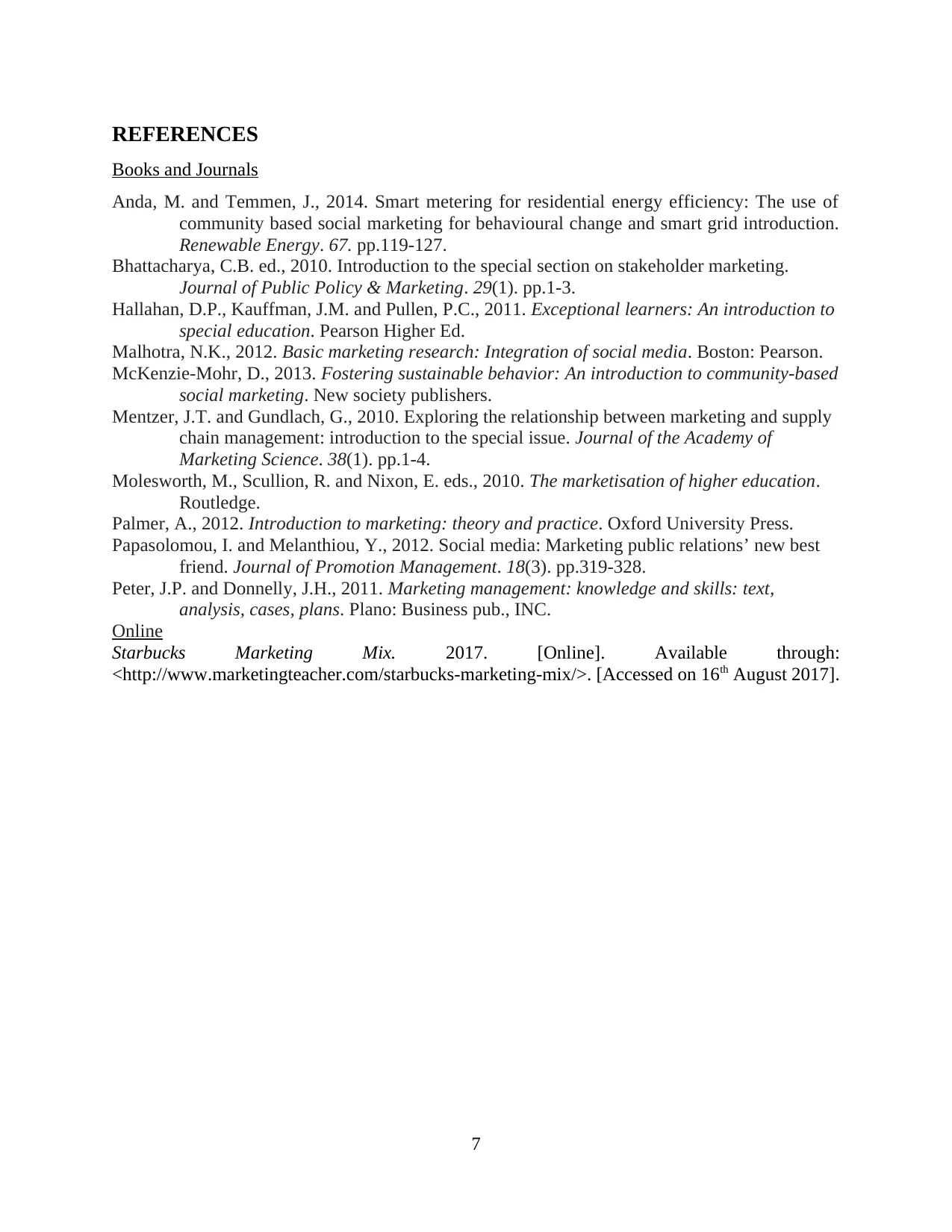
REFERENCES
Books and Journals
Anda, M. and Temmen, J., 2014. Smart metering for residential energy efficiency: The use of
community based social marketing for behavioural change and smart grid introduction.
Renewable Energy. 67. pp.119-127.
Bhattacharya, C.B. ed., 2010. Introduction to the special section on stakeholder marketing.
Journal of Public Policy & Marketing. 29(1). pp.1-3.
Hallahan, D.P., Kauffman, J.M. and Pullen, P.C., 2011. Exceptional learners: An introduction to
special education. Pearson Higher Ed.
Malhotra, N.K., 2012. Basic marketing research: Integration of social media. Boston: Pearson.
McKenzie-Mohr, D., 2013. Fostering sustainable behavior: An introduction to community-based
social marketing. New society publishers.
Mentzer, J.T. and Gundlach, G., 2010. Exploring the relationship between marketing and supply
chain management: introduction to the special issue. Journal of the Academy of
Marketing Science. 38(1). pp.1-4.
Molesworth, M., Scullion, R. and Nixon, E. eds., 2010. The marketisation of higher education.
Routledge.
Palmer, A., 2012. Introduction to marketing: theory and practice. Oxford University Press.
Papasolomou, I. and Melanthiou, Y., 2012. Social media: Marketing public relations’ new best
friend. Journal of Promotion Management. 18(3). pp.319-328.
Peter, J.P. and Donnelly, J.H., 2011. Marketing management: knowledge and skills: text,
analysis, cases, plans. Plano: Business pub., INC.
Online
Starbucks Marketing Mix. 2017. [Online]. Available through:
<http://www.marketingteacher.com/starbucks-marketing-mix/>. [Accessed on 16th August 2017].
7
Books and Journals
Anda, M. and Temmen, J., 2014. Smart metering for residential energy efficiency: The use of
community based social marketing for behavioural change and smart grid introduction.
Renewable Energy. 67. pp.119-127.
Bhattacharya, C.B. ed., 2010. Introduction to the special section on stakeholder marketing.
Journal of Public Policy & Marketing. 29(1). pp.1-3.
Hallahan, D.P., Kauffman, J.M. and Pullen, P.C., 2011. Exceptional learners: An introduction to
special education. Pearson Higher Ed.
Malhotra, N.K., 2012. Basic marketing research: Integration of social media. Boston: Pearson.
McKenzie-Mohr, D., 2013. Fostering sustainable behavior: An introduction to community-based
social marketing. New society publishers.
Mentzer, J.T. and Gundlach, G., 2010. Exploring the relationship between marketing and supply
chain management: introduction to the special issue. Journal of the Academy of
Marketing Science. 38(1). pp.1-4.
Molesworth, M., Scullion, R. and Nixon, E. eds., 2010. The marketisation of higher education.
Routledge.
Palmer, A., 2012. Introduction to marketing: theory and practice. Oxford University Press.
Papasolomou, I. and Melanthiou, Y., 2012. Social media: Marketing public relations’ new best
friend. Journal of Promotion Management. 18(3). pp.319-328.
Peter, J.P. and Donnelly, J.H., 2011. Marketing management: knowledge and skills: text,
analysis, cases, plans. Plano: Business pub., INC.
Online
Starbucks Marketing Mix. 2017. [Online]. Available through:
<http://www.marketingteacher.com/starbucks-marketing-mix/>. [Accessed on 16th August 2017].
7
⊘ This is a preview!⊘
Do you want full access?
Subscribe today to unlock all pages.

Trusted by 1+ million students worldwide
1 out of 9
Related Documents
Your All-in-One AI-Powered Toolkit for Academic Success.
+13062052269
info@desklib.com
Available 24*7 on WhatsApp / Email
![[object Object]](/_next/static/media/star-bottom.7253800d.svg)
Unlock your academic potential
Copyright © 2020–2025 A2Z Services. All Rights Reserved. Developed and managed by ZUCOL.





